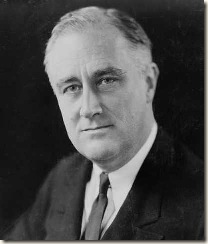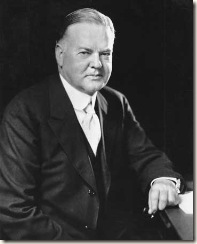Few presidents have had the lasting impact that Franklin Delano Roosevelt has had on American life. Lincoln, with the preservation of the Union and Emancipation Proclamation, and Washington, with his voluntary limitation to two terms and peaceful hand-over of power, come to mind. This impact was due in part to the fact that FDR is the only president to serve more than two terms (Nixon is the only person to spend more time as president or vice president). However, his legacy was pretty secure after his first two terms. After all, he led the nation through two of our most severe crises: the Great Depression and World War II.
Roosevelt entered New York politics with immense family wealth and a famous name. His distant cousin Theodore had been a popular governor of New York and president. As a state senator, he supported women’s suffrage and challenged powerful business interests. These policies led some Republicans to call FDR a “traitor to his class”. This is also the title of the biography that I read on FDR, written by H. W. Brands. Throughout his political career FDR consistently supported the rights of the common man against the interests of business and wealthy elite. I haven’t found anything that explains these views given his privileged background except to say that he knew he was given vast opportunities due solely to his being born into wealth and felt a sense of responsibility to support those that weren’t lucky enough to be born rich.
Early in his career FDR was already considering following in his cousin’s footsteps to running for president. He supported Wilson in the 1912 election (even though his cousin was running on the Bull Moose party). When Wilson won, FDR accepted a position as the Assistant Secretary of the Navy (the same position Teddy held during the McKinley administration). In this position FDR advocated for modernizing the Navy and, when World War I broke out, increasing its size. When war did begin FDR briefly considered following his cousin’s script, which would have meant resigning and joining the military to fight. Ultimately he decided against that track due in part to pressure from powerful people who felt that it would be derelict to abandon a job he had proved very good at with the Navy.
After the war he ran unsuccessfully in 1920 to be vice president. The presidential election of 1920 is an interesting one. During that election, six future or former presidents were in the running; Wilson (D), FDR (D), Hoover (R), Coolidge (R), Harding (R) and Theodore Roosevelt (Bull Moose). The election would ultimately be won by Harding.
FDR was stricken with what at the time was diagnosed as polio the following August 1921. He spent much of the next several years convinced that he was not permanently paralyzed and tried everything he could to regain his ability to walk. Eventually he was able to learn how to walk short distances with leg braces. He was always careful to not be seen in public in a wheelchair.
In 1928 he followed the next step in his cousin’s path by running for and winning the governors’ race in New York. During his two (two-year) terms as governor, FDR supported the reforestation of land, regulation of working hours, unemployment benefits and state control of the energy industry.
Due in large part to the continuing depression, FDR won the presidential election in 1932 by a wide margin over the incumbent Hoover. In fact, FDR won all four elections by wide electoral margins; the closest race was 1944 when he won 432-99 over Thomas Dewey.
The election of 1932 surrounded the government’s role in resolving the financial crisis. Hoover followed a cautious approach and believed that communities needed to help each other. FDR promised the New Deal; he defined his plan as series of federal programs to deliver aid to people, increased regulation of the stock market, stopping overproduction of certain crops and more government control of power utilities. He achieved many of these within the first 100 days of his administration.
In March 1933, when FDR took office the unemployment rate stood at 25%, farm prices had fallen by 60% and industrial output was done by half. FDR took office during the worst financial crisis in the nation’s history. On the eve of his inauguration 32 of the 48 states had closed their banks. For a long time I thought that when he stated “The only thing we have to fear is fear itself,” that he was talking about World War II. Rather, he used this phrase during his first inaugural speech in 1933 as reference to the banking crisis.
The first effort that FDR put forth was to stabilize the banking system. He called a special session of Congress and got to work. Congress passed the Emergency Banking Act to provide assistance to banks in trouble. FDR then cut the wages of federal employees to free up more money that could be sent to the local and state agencies as relief grants.
He then started up a series of programs to include large construction projects, clean-up work and conservation to get people back to work. As confidence began to grow, Roosevelt pushed more and more ideas through. He set up agencies to reform banking regulations, helped negotiations between businesses and employees, established a minimum wage and maximum work hours. The senses of urgency helped him get almost everything he wanted through Congress. Some days the administration would propose legislation, get it debated by Congress and signed into act by the president in the same day!
Historians generally group the New Deal into three categories: Relief, Recovery, and Reform. Relief bills were to get aid to the people that needed it, recovery bills were expected to get the economy moving again and reform bills implemented long-term systemic changes to the system.
A quick look at these bills introduced during FDR’s first term should be familiar:
Relief
Federal Emergency Relief Administration – designed to give aid to state agencies (created under Hoover, but greatly expanded)
Civil Works Administration (CWA) – provided work to a large number of men during the winters of 1933 and 1934
Work Projects Administration (WPA) – included road repair, building schools and libraries
Civilian Conservation Corp (CCC) – provided work to men in the areas of land improvement
National Youth Administration (NYA) – funded part-time jobs for high school and college students (Lyndon Johnson took advantage of this program.)
Recovery
Agricultural Adjustment Administration (AAA) – purchased surplus crops and paid farmers to reduce production; designed to restore crop prices (ruled unconstitutional)
National Recovery Administration (NRA) – designed to provide assistance to businesses by creating codes of fair conduct (ruled unconstitutional)
Public Works Administration (PWA) – designed to create jobs by building large public infrastructure; dams, irrigation systems and flood control projects
Reform
Federal Deposit Insurance Corporation (FDIC) – guaranteed deposits into participating banks up to a certain amount
Securities and Exchange Commission (SEC) – empowered to monitor the sale of stocks and bonds
Reciprocal Trade Agreements Act – empowered the president to negotiate trade agreements with other countries to lower taxes (This act created the “most favored nation status”.)
Federal Housing Administration (FHA) – insured home loans up to 80% of the home value.
Tennessee Value Authority (TVA) – created dams, provided electricity to people within seven states for the first time.
Social Security Act – provided a minimum income to people in old age
National Labor Relations Act – guaranteed workers the right to organize and bargain collectively
Some of these things were found to be completely or in part unconstitutional by the Supreme Court. This led FDR to an attempt to “stack the court” by increasing the size by as many as six new justices. This radical attempt at a power grab was even resisted by his fellow Democrats. The U.S. Constitution does not set the number of justices that sit on the Supreme Court; rather, it is left up to Congress to decide. They have had as few as six and as many as ten. The Supreme Court has been fixed at nine since 1869.
Most historians generally agree that while elements of the New Deal provided needed relief, the Great Depression did not end until the start of World War II. The United States supported the Allies including the Soviet Union and China through a series of Lend-Lease activities where we, in essence, sold them military equipment (tanks, planes, guns, etc). The deal was that we were not selling them the supplies because that could be seen as an act of war. Instead we expected the equipment returned. Robert Taft’s response was, “Lending war equipment is a good deal like lending chewing gum. You don't want it back.”
Writing about FDR in WWII is an entire post in itself, but he is credited with preparing the country for a war that he felt was inevitable even while he maintained a public neutral stance. He supported Churchill in launching an attack from the south (i.e. through Africa and Italy) instead of Stalin’s plea for a second front in Europe. In the late stages of the war, the decisions and agreements that FDR made with Stalin and Churchill would shape Europe and much of the world for the next 40 years, primarily the division of Germany and the fate of Eastern Europe (including Poland, for whom the British entered the war to defend).
During his inauguration address in 1941, FDR laid out principals that are carved into the monument in Washington DC: freedom of speech and expression, freedom of worship, freedom from want and freedom from fear. The last two expanded on the traditional Bill of Rights, but were based on the aftermath of the Great Depression and the ongoing war in Europe.
FDR’s legacy is secure (whether you agree with his policies or not) between the social safety nets, the government projects to try to end the Depression and his part in WWII.
Party Trivia:
- In 1945, because of FDR’s work with the March of Dimes organization, Congress voted to put his image on the coin. (He cofounded the organization in 1938 initially to combat polio.)
- He appointed eight justices to the Supreme Court, and only Washington appointed more (ten).
- By 1941 eight of the nine justices were FDR appointees.
- Teddy Roosevelt was also Eleanor Roosevelt’s uncle in addition to being a distant cousin of FDR’s.
- He was on the losing ticket as a vice presidential candidate in 1920. James Cox was the presidential candidate and lost to Warren Harding.
- FDR was only 38 years old when he was nominated by his party to be vice president, four years younger than his cousin Teddy.
- He is one of only two people to run for president or vice president five times for a major party. Nixon was the other. They both won four times and lost once.
- There is speculation that FDR suffered from Guillain-Barre syndrome, not polio.
- The twentieth amendment to the Constitution changed the date of the presidential inauguration from March 4th to January 20th, reducing the time for a lame duck president. The longer time was needed in the early years when transportation and communication took longer.
- He issued Executive Order 9250 in October 1942, later to be rescinded by Congress, which raised the marginal tax rate for salaries exceeding $25,000 (after tax) to 100%, thereby limiting salaries to $25,000 (about $356,000 today)
Vital Stats:
- Wife: Anna Eleanor Roosevelt
- Children: Anna Eleanor (1906-1975), James (1907-1991), Franklin Delano Jr. (1909-1909), Elliot (1910-1990), Franklin Delano Jr. (1914-1988), John Aspinwall (1916-1981)
- Party affiliation: Democratic Party
- Presidency: 1933-1945
- Born: January 30, 1882 (Hyde Park, New York)
- Died: April 12, 1945 (Warm Springs, Georgia)

